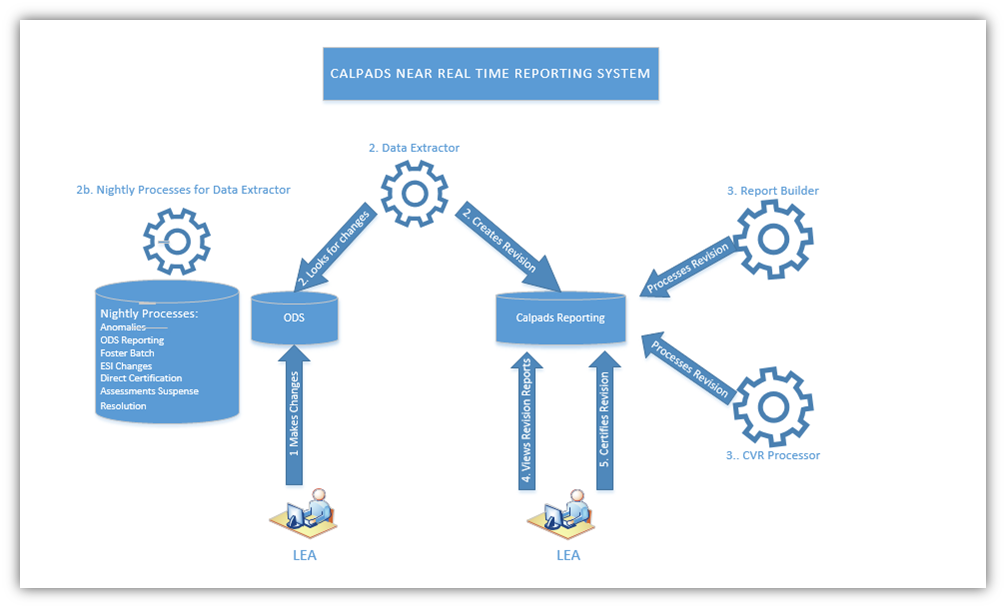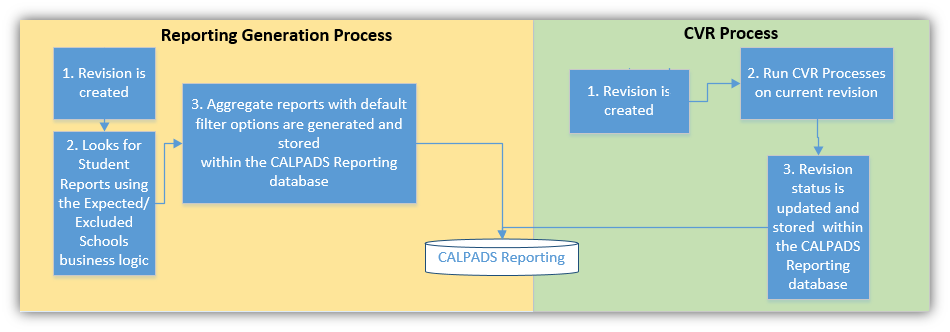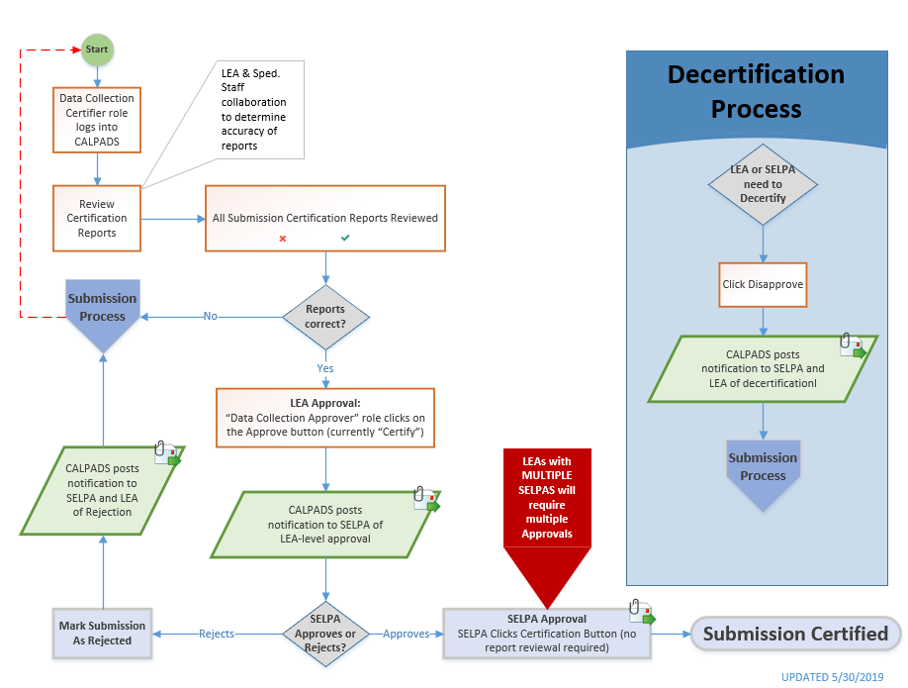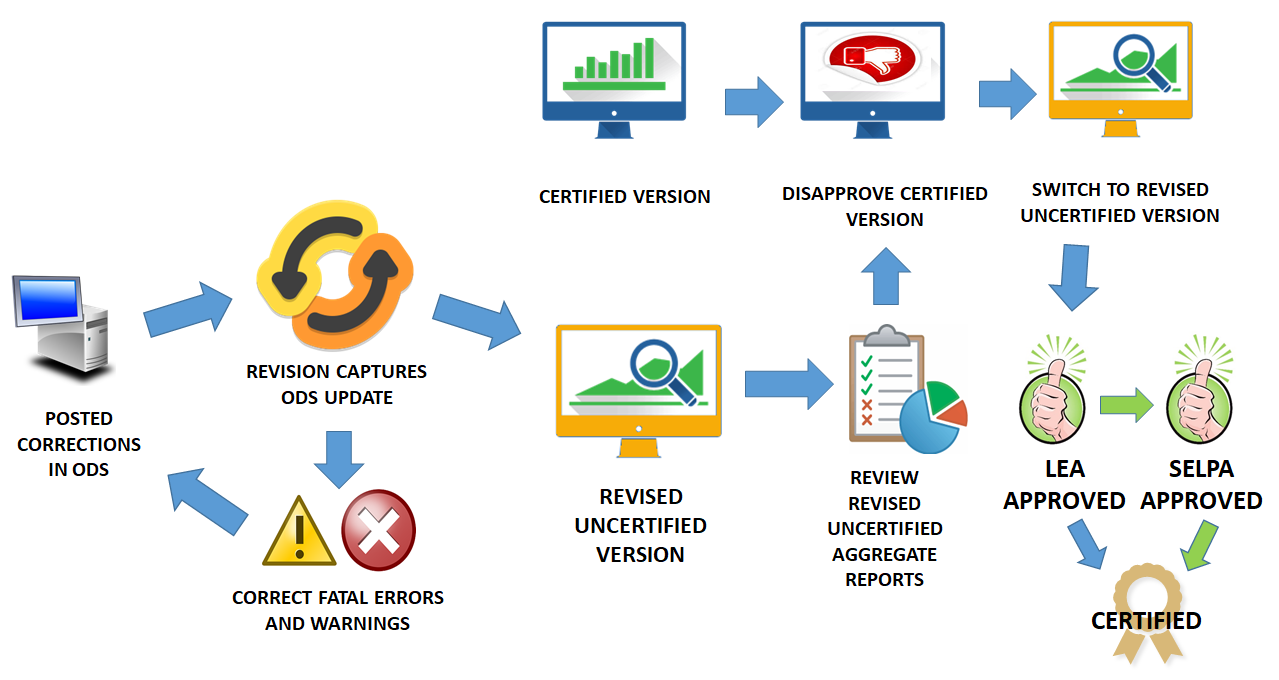Certification Process
Revision Process Overview

The above diagram represents the main components in the Revision process and the surrounding steps that result in Certification.
-
LEAs continually submit data to CALPADS ODS.
-
The Data Extractor component extracts and flags data from the CALPADS ODS into the CALPADS Reporting Database at a prescribed, configurable interval running throughout the day. (See section below for further details on frequency and flagging of data.) The Data Extractor also runs nightly for processes that require substantial processing resources.
-
Reports are generated and provided to the LEAs for review (see the Certification User Interface Specification on details of how LEAs review reports). Warnings and fatal certification errors are identified. Fatal errors must be resolved to prevent an LEA from certifying their revision (see section below on Certification Validation Rules and Excluded Schools for additional information on the validation rules process).
-
LEAs must review aggregate reports and supporting data to determine data accuracy.
a. LEAs may update the ODS data if needed and repeat steps 1- 4. The revised data will be incorporated into a newer version of the extracted data, known as a Revision.
-
LEAs are expected to certify the data is accurate and, if necessary, decertify data that has already been certified to allow for updates, as long as the Data Collection Window remains open for that specific submission. (See Reporting Calendar, Collection Window, and Amendment Window sections below for details on time frames for certification and decertification.)
CALPADS Data Extractor
The CALPADS Data Extractor (or the Data Extractor, for short) is a component that extracts and flags data from the CALPADS ODS into the CALPADS Reporting Database.
-
The Data Extractor is triggered for an LEA throughout the day by changes to the ODS when all files for that LEA have posted and 15 minutes have passed with no additional file upload or post activity by the moment Data Extractor triggers.
-
The Data Extractor is also triggered by nightly processes that require substantial processing resources. These nightly processes (Anomalies, Online or Batch files posted, ODS Reporting, Foster, ESI Changes, Direct Certification, Assessment Suspense Resolution) represent changes to the ODS, which also trigger the Data Extractor to create new Revisions for affected LEAs.
During the extraction process, the Data Extractor incorporates business rule calculations/classifications to flag records in the CALPADS Reporting Database.
The new version of the data extracted for an LEA is referred to as a Revision. There are differences between a Snapshot and a Revision. A snapshot identifies the data stored within CALPADS for a specific submission certification cycle and a revision is a version of that data within the snapshot that has a specific data and timestamp within that certification cycle.
Revision Characteristics
-
Revisions capture information for an open collection window (submission Fall1, Fall 2, etc.). Revisions are no longer generated when the amendment window ends for a submission
-
Revisions are a representation of data for a specific date and time available for an LEA within an Academic Year.
-
Revisions are generated continuously based upon changes within the ODS database within the defined Snapshot Collection window.
-
Certification reports are created based upon information available within a revision.
-
The data within the revisions meet specific criteria (LEA, Academic Year, etc).
Report Generation and CVR Process
Once the Data Extractor has created a new Revision, two components run concurrently: the Report Generator and the CVR Processor. These two components run in the background and listen for a new Revision every 10 minutes. These processes must both complete against a Revisions before it’s made available for review by an LEA.

The steps below describe the Snapshot Report Generator:
-
The Report Generator process begins when a new revision is created from the Data Extractor process.
-
The Report Generator process looks for specific types of data for a submission for the School and LEA levels standard reports. Expected Schools and Excluded schools business logic are also applied during this process.(see Certification Validation Rules (CVRs), Excluded and Expected Schools)
-
New aggregate reports are generated for each unique revision stored within the CALPADS Reporting database, so that it can be retrieved based upon the revision.
The CVR Processor runs concurrently with the Report Generation Process. The steps below describe the CVR process:
-
CVR Processor process also begins with a new revision that has been created from the Data Extractor process.
-
CVR validation procedures are identified for the particular submission are applied to the data in the current revision. CVR validations (Fatals & Warnings) for the revision are logged and stored within the CALPADS Reporting database until Expected Schools and Excluded schools business logic are applied during this process (see section below for business rules relating Certification Validation Rules (CVRs), Excluded and Expected Schools).
-
Once CVR Processing is completed, the new revision is given an initial Revision Status of “Revised Uncertified” and stored within the CALPADS Reporting database and made available to the UI with a specific date/time stamp. The Revision is now available for review and certification process
Due to the possible Many to Many relationships between LEAs and SELPAs: One LEA may need >1 SELPA to Approve a revision in order to be considered CERTIFIED. One SELPA may need to approve more than one LEA A SELPA may only Approve an LEA’s revision that has FIRST been approved by the LEA; they may NOT work on approving separate Revisions. Certification Reports are only aggregated at the LEA level, NOT school level. ESI Relationships between the SELPA and the LEA will drive the list of associated SELPAs or associated LEAs. It will also drive the SELPA or LEA dropdown filter on a Report. The actual SELPA Code that is submitted at the student level record will be used to filter out data based on the logged in SELPA user.
Revision Status vs Submission Status vs SELPA Approval Status
A Submission (e.g. Fall 1) can have multiple associated Revisions.
Submission Status is overall status of CERTIFIED or NOT CERTIFIED based on ONE of the associated Revisions.
Revision Status is the workflow status of that LEA’s revision, including the SUM OF ALL SELPAs.
SELPA Approval Status is the workflow status of the individual SELPA per SUBMISSION>LEA>REVISION
Due to the possible Many to Many relationships between LEAs and SELPAs:
- One LEA may need >1 SELPA to Approve a revision in order to be considered CERTIFIED.
- One SELPA may need to approve more than one LEA
- A SELPA may only Approve an LEA’s revision that has FIRST been approved by the LEA; they may NOT work on approving separate Revisions. Certification Reports are only aggregated at the LEA level, NOT school level.
- ESI Relationships between the SELPA and the LEA will drive the list of associated SELPAs or associated LEAs. It will also drive the SELPA or LEA dropdown filter on a Report.
- The actual SELPA Code that is submitted at the student level record will be used to filter out data based on the logged in SELPA user.
LEA Certification Process
Once the Data Extractor creates a Revision and both the Report Generator and CVR processor have been run against that revision, the LEA can view the new Revision in the Certification Details UI. Once the LEA has resolved all fatal errors and reviewed all required aggregate reports, the LEA may approve the revision. For specific submissions, LEAS may require a SELPA approval to finalize the certification.
There are two varying certification process that LEAs will encounter depending on the submission.
Fall 1, EOY 3 and EOY 4
This is a brief illustration of the certification process that LEAs and SELPAS will doing for the indicated submissions.

Certification Status, Revision Status, and SELPA Approval Status
The following tables demonstrate the actions that may change the status of a Revision, whether that change affects the submission’s overall Certification Status, and when an email is expected to be sent.
Fall 1, EOY3, EOY4 – SELPA Approvals Required for Certification
|
Actions |
Revision Status changes to |
Certification Status changes to |
Send Email? |
|
Revision is first created |
Revised Uncertified |
Uncertified |
|
|
LEA Manually checks In Review checkbox |
In Review Uncertified |
Uncertified |
|
|
LEA Reviews all required Certification Reports* |
Revised Uncertified or In Review Uncertified |
Uncertified |
|
|
LEA Approves Revision |
LEA Approved |
Uncertified |
Send email |
|
LEA Disapproves Revision |
LEA Disapproved |
Uncertified |
Send email |
|
Any one SELPA Approves Revision, but not all yet |
LEA Approved |
Uncertified |
Send email |
|
All associated SELPAs Approve Revision* |
SELPA Approved* |
Certified* |
Send email |
|
Any one SELPA Disapproves Revision |
SELPA Disapproved |
Uncertified |
Send email |
*NOTE: If there are MULTIPLE ASSOCIATED SELPAs, ALL must approve the revision before the Revision Status and Submission Status changes. It only takes ONE SELPA or the LEA to Disapprove a Revision, that will affect the Submission Status.
Fall 2, EOY 1, and EOY 2
This is a brief illustration of the certification process for LEAs. Fall 2, EOY 2 and 3 submissions do not involve SELPA approval.

Certification Status and Revision Status
The following tables demonstrate the actions that may change the status of a Revision, whether that change affects the submission’s overall Certification Status, and when an email is expected to be sent.
Fall 2, EOY1, EOY2 – SELPA Approvals NOT Required for Certification
|
Actions |
Revision Status changes to |
Certification Status changes to |
Send Email? |
|
Revision is first created |
Revised Uncertified |
Uncertified |
|
|
LEA Manually checks In Review checkbox |
In Review Uncertified |
Uncertified |
|
|
LEA Reviews all required Certification Reports** |
Revised Uncertified or In Review Uncertified |
Uncertified |
|
|
LEA Approves Revision |
LEA Approved |
Certified |
Send email |
|
LEA Disapproves Revision |
LEA Disapproved |
Uncertified |
Send email |
*Note: A Revision starts off with LEA Revision Status as New Revision and remains that way until the LEA either manually marks the In Review checkbox OR they Approve a revision.
How to Decertify
Below is a depiction of the recommended workflow for users needing to decertify to update their certified reports.

Step 1. When LEAs need to amend their certified reports, it is highly recommended that they don't click on the disapprove button before making corrections in the ODS. LEAs should take advantage of new revisions.
Step 2. Once the LEA approves a revision, all reports and statuses associate dto that revisions will be frozen. However, newer revisions will continue to be available to the LEA in parallel to the frozen LEA Approved versions, whenever changes in the ODS are made.
Step 3. LEA should first make the corrections in the ODS and wait for a new Revised Uncertified version. By default, the system will show the Certified version. Switch the Revision Status dropdown menu to Revised Uncertified or reveal that version.

Step 4. If there are no fatal errors or if the fatal errors are corrected and a new revision is generated, the LEA wil proceed to review the aggregate reports.
Step 5. If the aggregate reports from the Revised Uncertified version are all reviewed and considered accurate, the LEAs has to switch the Revisions status back to the LEA Approved version and click on the Disapprove button.
Step 6. Once the Disapprove button is clicked, user must switch Revision status to Revised Uncertified where the LEA Approval button should now be clickable.
Step 7. Once the LEA Approve button is clicked, Revision Status is updated to LEA Approved. Depending on the submission period (e.g. Fall 1, EOY 3, EOY4), LEAs may be required to seek a SELPA Approval before the certification is finalized. .
How to set In Review Status
LEAs have the ability to freeze a snapshot version of the data without certifying. This is useful when
- Users are waiting for other departments to review and sign off on the reports relevant to their department (e.g. CTE, Special Ed, Discipline)
- Users have accurate reports but are not ready to certify yet and avoid and problems caused by future CALPADS defects.
By clicking on the In Review button, LEAs can preserve this snapshot version.

Additional Resources
CALPADS Snapshot and Revision Video
This video clip covers the details of the CALPADS Snapshot Revision statuses and functionality through a live demo.
CALPADS Snapshot and Revision Video
This playlist provides an in-depth discussion and demonstration of the CALPADS Submission Certification process.